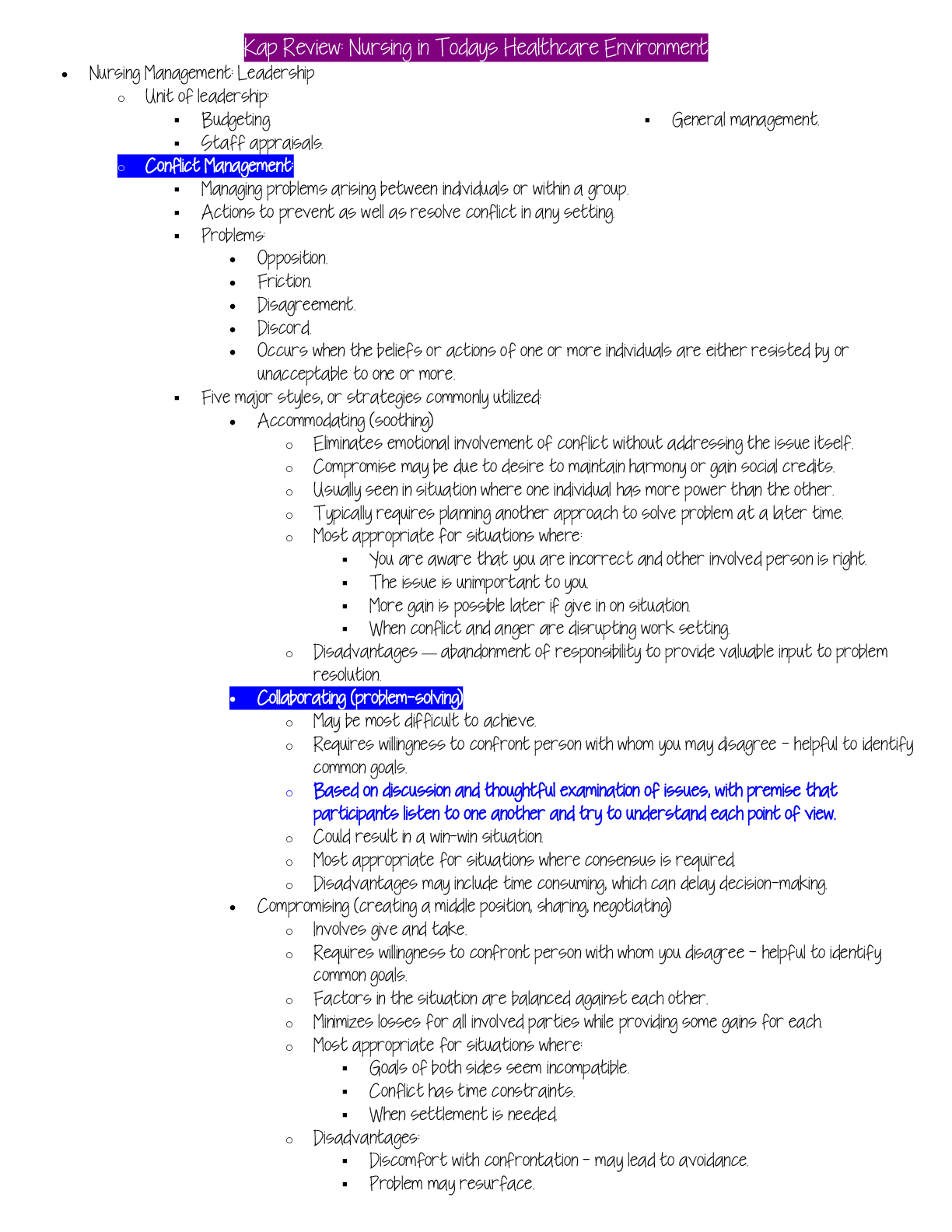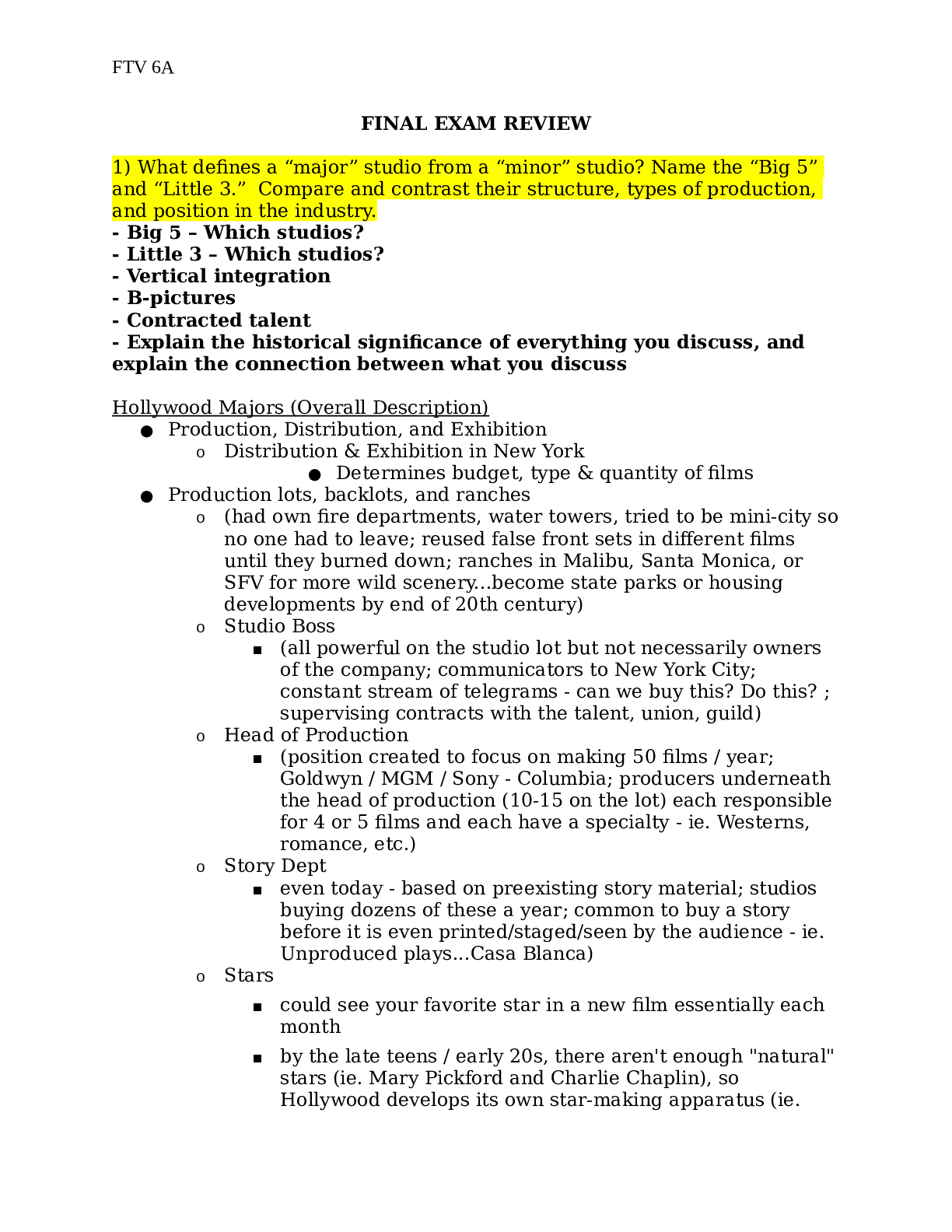*NURSING > EXAM REVIEW > Kap Review: Nursing in Todays Healthcare Environment (All)
Kap Review: Nursing in Todays Healthcare Environment
Document Content and Description Below
Nursing Management: Leadership o Unit of leadership: ▪ Budgeting. ▪ Staff appraisals. ▪ General management. o Conflict Management: ▪ Managing problems arising between individuals or with... in a group. ▪ Actions to prevent as well as resolve conflict in any setting. ▪ Problems: • Opposition. • Friction. • Disagreement. • Discord. • Occurs when the beliefs or actions of one or more individuals are either resisted by or unacceptable to one or more. ▪ Five major styles, or strategies commonly utilized: • Accommodating (soothing) o Eliminates emotional involvement of conflict without addressing the issue itself. o Compromise may be due to desire to maintain harmony or gain social credits. o Usually seen in situation where one individual has more power than the other. o Typically requires planning another approach to solve problem at a later time. o Most appropriate for situations where: ▪ You are aware that you are incorrect and other involved person is right. ▪ The issue is unimportant to you. ▪ More gain is possible later if give in on situation. ▪ When conflict and anger are disrupting work setting. o Disadvantages ⎯ abandonment of responsibility to provide valuable input to problem resolution. • Collaborating (problem-solving) o May be most difficult to achieve. o Requires willingness to confront person with whom you may disagree - helpful to identify common goals. o Based on discussion and thoughtful examination of issues, with premise that participants listen to one another and try to understand each point of view. o Could result in a win-win situation. o Most appropriate for situations where consensus is required. o Disadvantages may include time consuming, which can delay decision-making. • Compromising (creating a middle position, sharing, negotiating) o Involves give and take. o Requires willingness to confront person with whom you disagree - helpful to identify common goals. o Factors in the situation are balanced against each other. o Minimizes losses for all involved parties while providing some gains for each. o Most appropriate for situations where: ▪ Goals of both sides seem incompatible. ▪ Conflict has time constraints. ▪ When settlement is needed. o Disadvantages: ▪ Discomfort with confrontation - may lead to avoidance. ▪ Problem may resurface. • Avoiding (withdrawal) o Choosing not to address the issue at hand. o Most appropriate for situations where: ▪ More to be lost than gained by addressing conflict. ▪ Lack of adequate time to gather supporting data. ▪ Problem is only a symptom of a larger concern. ▪ You are not directly involved in problem. ▪ Situation will eventually resolve itself without intervention. ▪ Emotions are high and there is no imminent danger. o Disadvantages: ▪ Not intervening may produce less upset but may also result in loss of important information. ▪ May create internal conflict with personal value system - failing to report subordinate who is stealing supplies. • Competing (coercion or forcing) o Involves exclusively working for desired solution. o Used in situations where you feel you have greater expertise or more information than others involved in conflict. o Used in situation where compromise is not a solution. o Most appropriate for situations where need to resolve a deadlocked issue. o Disadvantages: ▪ May not consider needs and opinions of other person(s) involved. ▪ May result in win-lose situation. ▪ Assessment: • If conflict is occurring. • Which individuals are involved with conflict. • Which strategy works best in a specific situation. • How to best resolve the conflict. ▪ Planning: • Select appropriate strategy for particular situation. • Plan tactics that achieve better working relationships and get more of what each person wants. • Use ways to: o Gain respect. o Improve self-esteem. o Build courage. ▪ Mediating Conflict: • A mediator may be enlisted to act as an intermediary or conciliator between disagreeing sides or persons involved in a conflict. • Steps taken may include: o Assess the conflict. o Analyze the information and determine facts. o Determine solutions. o Design the process for mediation. o Consider timetables. • Implement solutions: o Arrange a meeting of involved persons. o Ask for suggestions for resolution from those involved. o Consider all possible alternatives and narrow choices for action. o Plan implementation for decision. o Evaluate results. o Evaluate conflict resolution. • Intervention by a third party may also be withheld if: o Persons in conflict should resolve their issues themselves. o Third party does not have control over the problem. ▪ Implementation: • Don’t avoid conflict unless it helps create a delay that allows people to cool down or gather more information. • Before addressing the person with whom there is a conflict, discuss the situation with an objective colleague. • Seek feedback and advice in dealing with the situation. • Get facts before jumping to conclusions. • Utilize most appropriate style/strategy. • Talk out conflict face to face, if possible. • Use mediator, if necessary. • Apologize when appropriate. • Utilize effective communication skills. ▪ Steps of conflict resolution: • Determine the facts. • Identify the problem. • Ask for suggestions for resolution from those involved. • Determine the solution. • Evaluate the results. • Evaluate the conflict resolution. ▪ Prevention: observations of potential conflict and steps to prevent conflict from occurring. ▪ Possible Outcomes: • Win-win situation: both parties achieve all or most of their goals or desires. • Win-lose situation: one person or group achieves desired outcome, and the other person or group fails to obtain what is desired. • Lose-lose situation: outcome is unsatisfactory to both parties. o Leadership Styles: ▪ Autocratic: • Leader maintains full control of decision-making, planning, and issuing of orders. • Discourages independence. • Uses coercion. • Emphasizes status differences. ▪ Democratic leader: • Less controlling than autocratic leader. • Encourages participative planning and decision-making. • Offers suggestions. • Encourages independence. • Motivates with economic and personal satisfaction rewards. ▪ Laissez-faire leader: • Exerts little or no control or direction in planning, decision-making, or action. • Gives support when it is requested. • Emphasizes the group. • Situational or contingency leader: • Exhibits behaviors along a continuum from autocratic to laissez-faire. • Dependent upon each new situation. ▪ Transactional leader: • Serves as caretaker. • Task-oriented. • Provides rewards for meeting of goals. ▪ Transformational leader: • Committed, inspirational, process oriented. • Identifies common values. [Show More]
Last updated: 2 years ago
Preview 1 out of 56 pages

Buy this document to get the full access instantly
Instant Download Access after purchase
Buy NowInstant download
We Accept:

Reviews( 0 )
$14.00
Can't find what you want? Try our AI powered Search
Document information
Connected school, study & course
About the document
Uploaded On
Apr 07, 2021
Number of pages
56
Written in
Additional information
This document has been written for:
Uploaded
Apr 07, 2021
Downloads
0
Views
93









.png)



